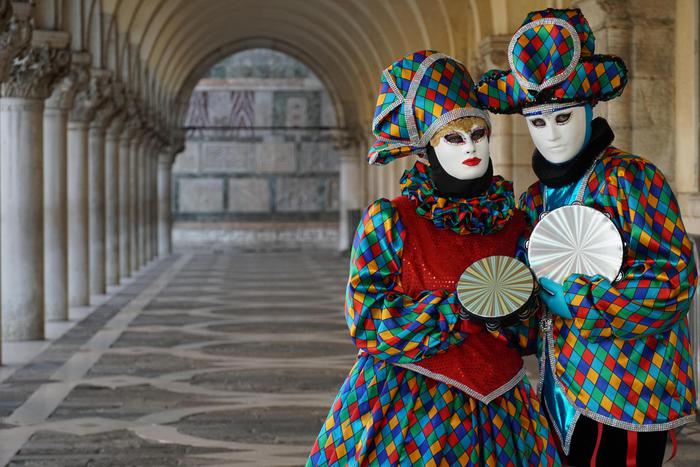In the collective imagination it is often connected to the glories and transgressions of the seventeenth and eighteenth centuries, also thanks to the famous paintings by Francesco Guardi and Pietro Longhi, in addition to the theatrical works of Carlo Goldoni and the writings of Giacomo Casanova.
But in reality, the seventeenth-eighteenth century is only a moment in the long and complex history of
the Venice Carnival,
today perhaps the best known and most spectacular festivity of the lagoon city, which this year celebrates 1600 years.
Appearing at the end of the 11th century, the Venetian Carnival soon became one of the key episodes of an important ritual aimed at celebrating the political and economic success of the Serenissima;
its celebratory and festive dimension is gradually refined over time until it became, in the 18th century, the symbol par excellence of urban carnivals throughout Europe.
Over the centuries, no one has remained immune to the changing charm and mystery of the millenary Venetian Carnival, let alone Professor Gilles Bertrand, professor of modern history at the University of Grenoble Alpes, and one of the leading experts in the history of the Venice Carnival.
Although
the etymology, the Latin "carnem levare"
that is “depriving oneself of the flesh”, both of Christian derivation, the roots of the carnival tradition refer to an even more remote time, in which
the passage from winter to spring was celebrated
.
Already the Dionysian cults in Ancient Greece and the Saturnalia in Roman times indicated a period of the year in which it was
allowed to subvert the rigid social order
.
But the first testimony of the Carnival in Venice is a document of the doge Vitale Falier,
dated 1094, in which he speaks of public entertainment,
while in 1296 the day before Lent officially becomes, thanks to an edict of the Senate of the Serenissima Republic, a public holiday.
However, the documents are not very numerous during the Middle Ages, and it seems that the Carnival of Venice was very similar to that of other cities in Mediterranean Europe, at least until the 13th century.
At this time, the festivities lasted six weeks, from December 26th to Ash Wednesday, although the festivities were sometimes started as early as the first days of October.
It is only from the fourteenth century that a properly Venetian Carnival begins to be developed, which fits into a context of a clear political and economic matrix.
“In addition to the religious dimension”, explains Professor Bertrand, “Carnival had at least two other functions.
, the cohesion of the population of the neighborhoods
, using the memory of historical or legendary events that aimed to remember the successes and the progressive extension of the dominion of the Republic.
But there was also, at a certain point,
a dimension of economic survival, linked to the ability to be seen as a luxurious and attractive city
towards which people from all over Europe converged.
This third function, one could say, extended from the beginning of the modern era, that is, from the mid-sixteenth century, to the time of Titian and Veronese, until the end of the Republic in 1797. This meaning began to acquire a pre-
eminence when
the economic and diplomatic prestige of Venice,
at its peak, in the fourteenth and fifteenth centuries, it weakened.
Venice then tried to maintain itself as a prestigious, rich and opulent capital in the eyes of kings, aristocrats, merchants and artists from all over Europe ".
The Carnival of Venice is a moment of leisure for all social classes, both for the people and for the nobility, even if certain distinctions remain in force.
“Everyone had fun”, says Professor Bertrand, “and for certain carnival shows, such as regattas, bull hunts or the feast of Fat Thursday, the people and the nobles could come together.
Everyone could cross paths in Campo Santo Stefano or in Piazza San Marco.
But overall there was a real rift, even on those occasions.
With
the practice of liston
the nobles showed themselves in front of everyone, making them understand their difference with the people.
Even
the disguise in bautta
he did not make the conditions the same, as the quality of a lace or the way of arranging the tricorn on the head were so many signs of gratitude.
The people in modern times, and perhaps even more so in the nineteenth century, liked to enjoy Carnival as a time of pleasures for the throat, while the phobia of the crowd pushed nobles to go to their villas outside Venice, in order to escape the noise " .
Carnival celebrations in Venice undergo profound metamorphosis over the centuries, and are made up of countless events, some more refined, others more popular.
“Certain games, rituals and celebrations that were very popular with the people during the Middle Ages gradually disappeared, because they were considered too violent.
First in the mid-sixteenth century a more refined Carnival was established in its costumes and in the way of dressing up, more controlled by the government, complete with private parties on the one hand, separated from the popular ones, and collective celebrations on the other, intended for dazzle Venetians and foreigners, playing on the merits and magnificence of the scenery, in particular that of Piazza San Marco and the Grand Canal.
Secondly, the military dimension and protection against hostile natural elements had generated acrobatic exercises or fights between groups of young people or with animals: the government tried to keep them to please the people, but little by little they were interrupted ".
Among the events that disappear, they are also remembered
and collective celebrations on the other, destined to dazzle Venetians and foreigners, playing on the merits and magnificence of the scenery, in particular that of Piazza San Marco and the Grand Canal.
Secondly, the military dimension and protection against hostile natural elements had generated acrobatic exercises or fights between groups of young people or with animals: the government tried to keep them to please the people, but little by little they were interrupted ".
Among the events that disappear, they are also remembered
and collective celebrations on the other, destined to dazzle Venetians and foreigners, playing on the merits and magnificence of the scenery, in particular that of Piazza San Marco and the Grand Canal.
Secondly, the military dimension and protection against hostile natural elements had generated acrobatic exercises or fights between groups of young people or with animals: the government tried to keep them to please the people, but little by little they were interrupted ".
Among the events that disappear, they are also remembered
the military dimension and protection against hostile natural elements had generated acrobatic exercises or fights between groups of young people or with animals: the government tried to keep them to please the people, but little by little they were interrupted ".
Among the events that disappear, they are also remembered
the military dimension and protection against hostile natural elements had generated acrobatic exercises or fights between groups of young people or with animals: the government tried to keep them to please the people, but little by little they were interrupted ".
Among the events that disappear, they are also remembered
the fist fight
between Castellani and Nicolotti, abolished in 1705, the bull hunts (1802) and, in 1816, the popular show of the Forces of Hercules with
human pyramids
in Piazzetta San Marco.
Unfortunately, with the fall of the Serenissima and the French and Austrian occupation of 1797, the very long tradition of the Venice Carnival was interrupted for fear of rebellions and popular unrest.
"The need for Venice to be seen beautiful in the eyes of all of Europe disappears", says Professor Bertrand, "and to use Carnival as a showcase destined to let people know that it remained independent, rich and sumptuous as in the days in which it dominated the Mediterranean, in the fourteenth and fifteenth centuries.
Furthermore, the French arrive with a suspicion, typical of revolutionary times, against the mask and disguise;
then follows the will of the Austrians to reorganize this ancient capital as a simple provincial capital.
Few theaters, few pleasures: Carnival first disappears, then after the Napoleonic era, and then under the second Austrian rule, its events are limited to the opening of theaters, to some dances, to regattas and to masquerades in the streets ,
until the complete disappearance of its public expressions with the unification of Italy.
For decades, Carnival was mostly limited to nostalgic parties in private buildings and with the competition of artists ".
Only in the islands of the Venice lagoon, such as Murano and Burano, do the celebrations continue, maintaining vigor and joy.
The revival of this millenary tradition comes almost two centuries later, in 1979, on the initiative of the Municipality of Venice and some city associations.
Masks, costumes, parades, dances
: the Carnival of Venice, now celebrated every year in the ten days preceding Lent,
is largely inspired by the baroque atmospheres of the seventeenth century, as well as the splendor of the eighteenth century
.
Often distinguished and dedicated to a basic theme, the new editions of the Carnival have also been enriched with numerous events inspired by the history and traditions of the lagoon city, such as the Festa delle Marie and the Flight of the Angel.









